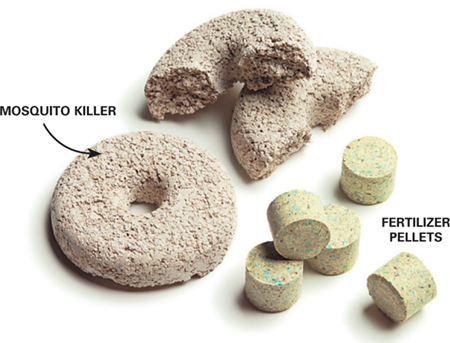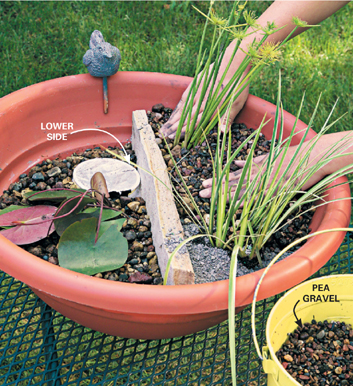

What it takes
Time: 2 hours
Skill level: Beginner
Container gardens with aquatic plants create more mystery than plants potted in soil. They make you want to go outside and have a look. Plus, they’re extremely low maintenance. Top them off with water before you go on vacation, and they’re still bright and beautiful when you come home. And if you add a spouting ornament or water movement of any kind, the kids will love it even more than you do.
Container water gardens are inexpensive and easy to build, too. So here’s how to get into the swim of things with a container water garden.
For a basic garden, you need at least an 18- to 20-in. plastic container that’s 7 to 8 in. deep, a small submersible pump, a spouting ornament, plants, clear vinyl tubing, clean cat litter, pea gravel or small pebbles and a nylon stocking. Most items are readily available at larger garden centers or online.
The photos show you how. Here are a few additional tips:
• The floor is two-tiered to allow for different types of plants; the lilies planted on the deep side have stems that float upward and extend horizontally, while the “marginal” plants—those that grow upright and favor shallower water—stand on the higher side. The partition that separates the two sides can be made from stone, bricks or other heavy material.
• Pea gravel both beautifies your water garden and acts as a lid over the unpotted soil so it can’t circulate and darken the water. Rinse the pea gravel before adding it to the container.
• For extra protection, place the pump in a nylon stocking before putting it in the cup, then stuff the extra nylon over the pump. This filtering is crucial; otherwise pebbles and cat litter will be drawn into the pump and clog it. A well-filtered pump will run for months; a clogged pump must be dug up, which fouls the water.
• Small submersible pumps have adjustable pressure, so before burying the pump, place it in a bucket of water, plug it in and adjust the pressure of the jet of water coming out of the spouter.
• Fill a couple of buckets with tap water, then let them sit for a day or two to allow chlorine to evaporate and water temperature to moderate. Pour the water in gradually—it should be as clear as a mountain stream.
• Aquatic plants thrive on direct sunlight, so a bright sunny spot is ideal. If possible, position the container near an electrical outlet for the pump.
Taking care of water gardens is a breeze. Top them off as water evaporates and scoop off the occasional dead leaf or bit of algae.
Plants maintain water clarity by absorbing decaying matter through their roots as food. But if the water starts looking gunky, remove the plants, rinse the container and refill.
For any plants needing a boost, press a fertilizer pellet into the potting soil. You can also add a mosquito killer (sold at garden centers) a couple times in the summer to kill mosquito larvae without posing harm to people or pets. Smaller containers will only need a small piece.
For a small container, plant a dwarf lily so the pads don’t completely cover the surface as they grow. For larger water gardens, you can add a floating plant like water hyacinth, duckweed or water lettuce.
A dish-style garden is too small for goldfish, but larger containers, like whiskey barrels or larger terra-cotta pots, are ideal. (Note: Water in metal containers usually gets too warm for fish.) Fish help keep the garden clean by eating algae, decaying plant material and mosquito larvae. Make certain to read up on fish so you give them the proper care and learn how they will impact your garden.


2
Spread the soil of the lily or other deep-water plants in one half of the container, then add cat litter to create a level floor.

4
Spread pea gravel over the cat litter. Keep the floor on the lily side lower to allow the lily stems room to extend upward when you add water.

6
Cover the pump with a nylon stocking filter to keep gravel from clogging the pump, and then cover the pump with pea gravel.